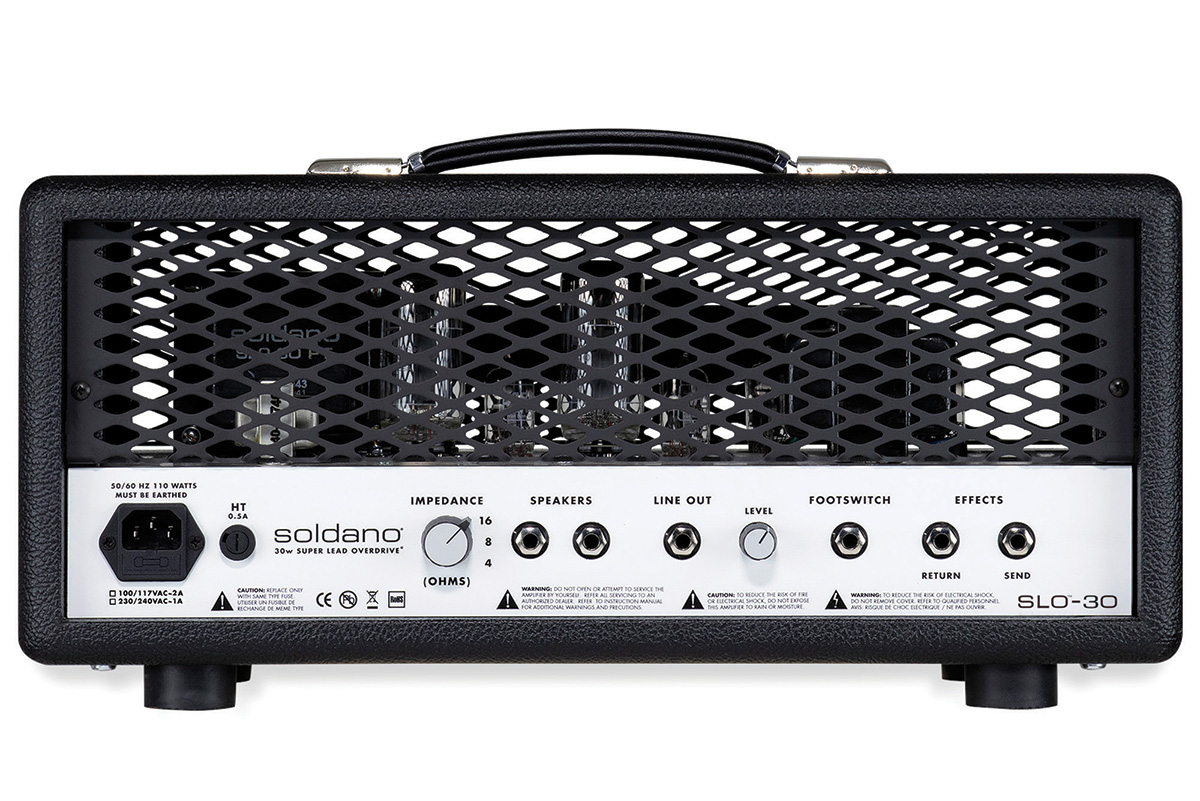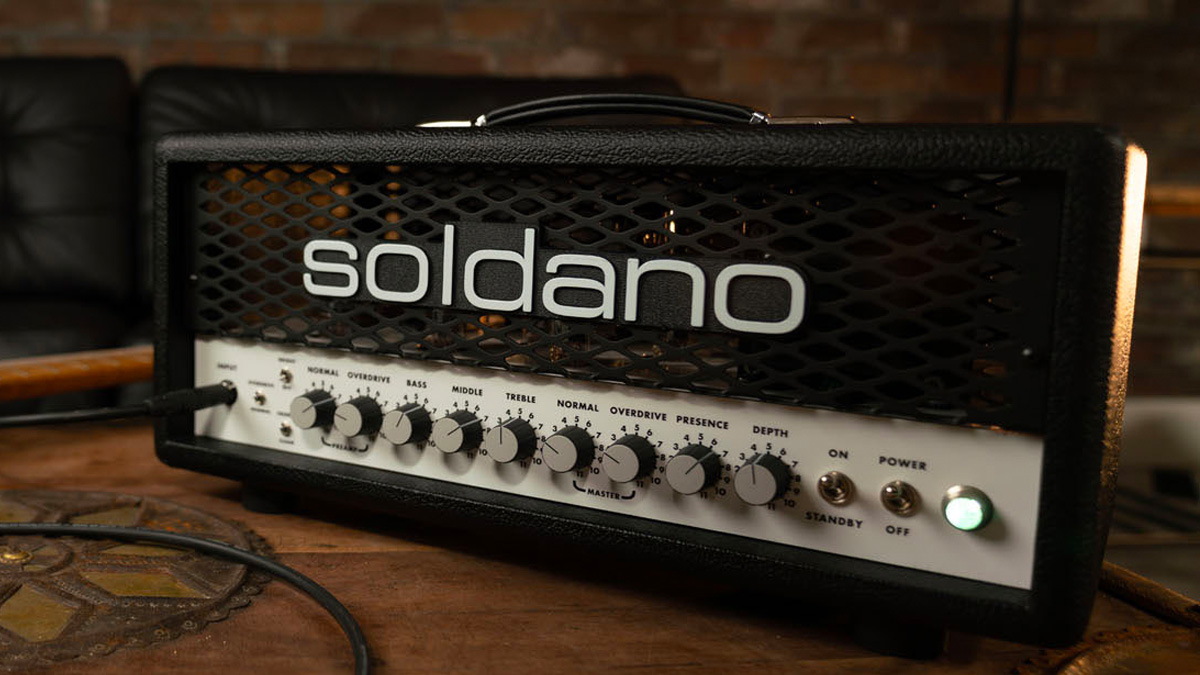GuitarPlayer Verdict
That sizzling hot overdrive you like is back in style, with Soldano rolling back the years with a supremely capable tube head. It's not cheap but then the really good stuff rarely is. Little wonder it was a favorite of the world's greatest players.
Pros
- +
Impeccably built by hand.
- +
Sounds great at low volumes.
- +
Capable of producing a wide range of top-shelf overdriven sounds as well as epochal high-gain distortion tones.
Cons
- -
None, but a foot-switchable effects loop would be nice at this price.
You can trust Guitar Player.
When Michael Soldano put the Super Lead Overdrive 100 into production in 1987, he could hardly have known it would become a benchmark of the amplifier industry that would remain in production more than 30 years later.
What he did intuit correctly, however, was that guitarists seeking to dial in the high-gain lead sounds that were popular at the time were being woefully underserved by the larger amplifier manufacturers of the era, whose stock offerings required expensive (and often noisy) aftermarket modifications to attain desired levels of sustain and drive.
Early adopters included luminaries like Toto guitarist and session ace Steve Lukather, Lou Reed, Eric Clapton, and, perhaps more crucial to the SLO’s enduring legacy, a cohort of heavy metal shredders like Dokken’s George Lynch, Ratt’s Warren DeMartini, and Steve Vai
Soldano’s SLO, on the other hand, offered gobs of gain right out of the box, and could do so at a sensible volume, since the amp’s overdrive sound was generated entirely in the preamp section and therefore did not require ear-splitting power amp or output transformer saturation.
Word of the SLO spread quickly, and early adopters included luminaries like Toto guitarist and session ace Steve Lukather, Lou Reed, Eric Clapton and, perhaps more crucial to the SLO’s enduring legacy, a cohort of heavy metal shredders like Dokken’s George Lynch, Ratt’s Warren DeMartini, and Steve Vai.
From the early 1990s, Soldano and a small team of employees handled all the company’s production in his Seattle workshop, but in late 2018, Soldano announced he would sell his company to the larger Boutique Amps Distribution company.

Manufacturing would shift to B.A.D.’s Huntington Park, California, headquarters, where they also hand-build amps for other high-end brands, like Friedman, Morgan, Synergy, and Tone King. Soldano, meanwhile, would remain involved as an adviser and design new products for the line bearing his name.
After successfully bringing the flagship SLO-100 to market, the first fruit of this new arrangement is the Super Lead Overdrive 30, a more affordable “small box” version of the flagship SLO-100 (which B.A.D. initially collaborated on for the redesign).
All the latest guitar news, interviews, lessons, reviews, deals and more, direct to your inbox!
The 30 employs a five 12AX7–equipped preamp circuit identical to the 100’s but is powered by a duet (versus the 100’s quartet) of 5881 tubes, a power-plant profile more appropriate to recording studios, small stages, and home users than its bigger brother’s.
Soldano notes that this lightened tube complement could well have yielded 50 watts, but he wanted to keep plate voltages across the power tubes low enough to allow them to “give” a little at high-volume settings.

Although SLO-30s can be ordered with several cosmetic options, including bright purple and even snakeskin Tolex, our review amp was the base-model black variant with a matching metal grille.
At 30 pounds, the head is a breeze to lift, and nary a grunt, sigh, or whimper was emitted when I removed it from its shipping box and placed it atop a Celestion Vintage 30–equipped Bogner 4x12 cabinet.
Plugging into the SLO-30 with a Whitfill Telecaster-style guitar with proprietary Onomac Windery pickups, I quickly realized why the Claptons and Reeds of the music world were enamored of the SLO
Front-panel controls include a trio of mini switches (a global bright switch, a Normal or Overdrive channel selector, and a switch to toggle between the Normal channel’s Clean and Crunch modes), individual gain and master volume controls for each channel, and shared bass, middle, and treble controls, as well as shared presence and depth controls that adjust, respectively, the amount of high and low frequencies being generated in the power section of the amp.
Power and standby switches also reside on the front of the unit, a boon for studio owners who stack multiple heads in their control rooms. A quick look at the rear of the SLO-30 reveals an impedance selector, two speaker outputs, a post-power section line-level out, a jack for the included channel foot switch, and send and returns for a tube-buffered effects loop.
According to Soldano, this newly designed circuit replaces the SLO’s original, more finicky loop and promises to play nicely with both instrument-level stomp boxes (it did so with my Catalinbread Topanga spring reverb and MXR Carbon Copy delay) and high-end line-level rack effects.
Plugging into the SLO-30 with a Whitfill Telecaster-style guitar with proprietary Onomac Windery pickups, I quickly realized why the Claptons and Reeds of the music world were enamored of the SLO. The Normal channel (with the bright switch engaged, counterintuitively) yielded flattering, tight-bottomed, snappy clean sounds that were never shrill.
Switching the Normal channel to Crunch mode produced a refined and inspiring range of ever-so-lightly (and forgivingly) compressed colors. From a smattering of Keef-esque growl to more aggressive hard-rock rhythm crunch, there’s really no color in the overdrive rainbow that you can’t conjure by correctly balancing the gain and tone controls and fine tuning the amp’s character with the depth and presence knobs.
Even with the Whitfill Tele-style, engaging the Overdrive channel unleashed a bounty of molten gain and sustain while conserving the oomph of every pick attack.
However, when confronted with a Jackson USA Soloist loaded with a Seymour Duncan JB bridge pickup, the SLO became a veritable sonic time machine, transporting me back to the 1980s glory days of the Sunset Strip and the hard rock it spawned.
Maybe it’s because so many of the licks and riffs of the era were actually recorded using Soldanos, but this amp really has the sound.
The low-end punch of low-E string pedal tones, the harmonic richness of staccato dyad riffs, the legato run and dive bomb–friendly sustain – it’s all there. And due to the fact that Soldano now uses DC heaters on its preamp tubes, there was almost none of the extraneous noise or hiss endemic to most high-gain amps.
I suspect its 30 watts would prove sufficient in almost any live situation, and probably even elicit the required, “Can you turn that down?” from your curmudgeonly front-of-house engineer
That said, a word of caution: This amp is not particularly well-suited to reproducing the mid-scooped thrash sounds that also rose to prominence in the late ’80s. The frequency range and Q (width) of the midrange control don’t attenuate the correct frequencies, and the amp sounds hollow and diminished, not lean and mean, with it dialed down.
Given these times, I was not able to test the SLO-30 in performance, but I suspect its 30 watts would prove sufficient in almost any live situation, and probably even elicit the required, “Can you turn that down?” from your curmudgeonly front-of-house engineer.
The good news is that rolling back the master volume will cost you virtually nothing in terms of tone. The SLO really does sound great at almost any volume, even bedroom-safe woodshedding levels. Sure, at $2,699 street, it’s expensive. But you only live once.
Specifications
- PRICE: $2,699 street
- CHANNELS: 2 (Normal and Overdrive)
- CONTROLS: Normal channel gain, Overdrive channel gain, bass, middle, treble, Normal master volume, Overdrive master volume, presence, depth, bright switch, channel select switch, Clean/Crunch mode switch (Normal channel)
- POWER: 30 watts
- TUBES: five 12AX7 preamp tubes, two 6L6 power tubes
- EXTRAS: Foot-switchable channels (footswitch included), post power-stage line output, tube-buffered effects loop
- WEIGHT: 30 lbs.
- BUILT: USA
- CONTACT: Soldano

